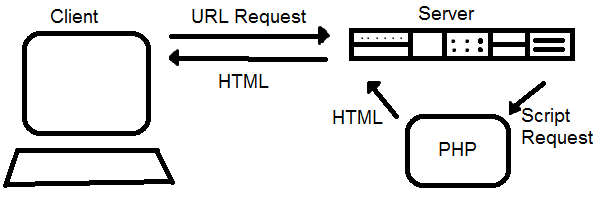Cameron Garnett/Testpage3
Contents
Super Quick PHP Tutorial
Introduction | Basic Syntax | Sending Data to the Browser | Comments | Variables | Strings | Functions | Quotes | Debugging | Form
Introduction
Overview
Learning ObjectivesBy the end of this Tutorial you will be able to understand some basic syntax and functions used when coding with PHP. |
PHP is a server-side scripting language designed for web development but also used as a general-purpose programming language. As of January 2013, PHP was installed on more than 240 million websites (39% of those sampled) and 2.1 million web servers. Originally created by Rasmus Lerdorf in 1994, the reference implementation of PHP (powered by the Zend Engine) is now produced by The PHP Group. While PHP originally stood for Personal Home Page, it now stands for PHP: Hypertext Preprocessor, which is a recursive backronym.
PHP code can be simply mixed with HTML code, or it can be used in combination with various templating engines and web frameworks. PHP code is usually processed by a PHP interpreter, which is usually implemented as a web server's native module or a Common Gateway Interface (CGI) executable. After the PHP code is interpreted and executed, the web server sends resulting output to its client, usually in form of a part of the generated web page; for example, PHP code can generate a web page's HTML code, an image, or some other data. PHP has also evolved to include a command-line interface (CLI) capability and can be used instandalone graphical applications.
The canonical PHP interpreter, powered by the Zend Engine, is free software released under the PHP License. PHP has been widely ported and can be deployed on most web servers on almost every operating system and platform, free of charge.
Despite its popularity, no written specification or standard existed for the PHP language until 2014, leaving the canonical PHP interpreter as a de facto standard. Since 2014, there is ongoing work on creating a formal PHP specification.
Brief History
PHP development began in 1994 when Rasmus Lerdorf wrote a series of Common Gateway Interface (CGI) binaries in C, which he used to maintain his personal homepage. He extended them to add the ability to work with web forms and to communicate with databases, and called this implementation "Personal Home Page/Forms Interpreter" or PHP/FI.
PHP/FI could be used to build simple, dynamic web applications. Lerdorf initially announced the release of PHP/FI as "Personal Home Page Tools (PHP Tools) version 1.0" publicly to accelerate bug location and improve the code, on the Usenet discussion group comp.infosystems.www.authoring.cgi on June 8, 1995. This release already had the basic functionality that PHP has as of 2013. This included Perl-like variables, form handling, and the ability to embed HTML. The syntax resembled that of Perl but was simpler, more limited and less consistent.
Zeev Suraski and Andi Gutmans rewrote the parser in 1997 and formed the base of PHP 3, changing the language's name to the recursive acronym PHP: Hypertext Preprocessor. Afterwards, public testing of PHP 3 began, and the official launch came in June 1998. Suraski and Gutmans then started a new rewrite of PHP's core, producing the Zend Engine in 1999. They also founded Zend Technologies in Ramat Gan, Israel.
On May 22, 2000, PHP 4, powered by the Zend Engine 1.0, was released. As of August 2008 this branch reached version 4.4.9. PHP 4 is no longer under development nor will any security updates be released.
Many high-profile open-source projects ceased to support PHP 4 in new code as of February 5, 2008, because of the GoPHP5 initiative, provided by a consortium of PHP developers promoting the transition from PHP 4 to PHP 5.
How Does PHP work?
How PHP fits into the client/Server model when a user requests a Web Page
|
ACTIVITY: Briefly Describe What PHP is? |
|---|
|
PHP is a server side scripting language used for web development. |
|
ACTIVITY: What does PHP stand for? |
|---|
|
Hypertext Preprocessor. |

